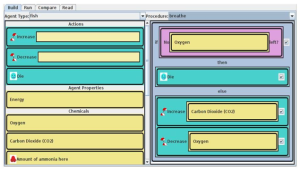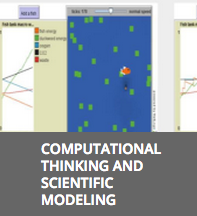Based on a submission by Gautam Biswas about his NSF-funded project to foster computational thinking through scientific modeling and simulation.

Computational Thinking (CT) is now considered a core competency in problem formulation and problem solving. In spite of the known synergies between CT and science education, integrating CT in K-12 science classrooms is challenging. CTSiM, a visual programming environment that supports development and practice of curricular units specifically for middle school classrooms, has successfully demonstrated that these challenges can be overcome and lead to demonstrable learning gains in middle school classrooms. When adopted on a wider scale, this project will result in strengthening a STEM-oriented computation-ready workforce.
NSF Project Information
Title: EXP: CTSiM: Fostering Computational Thinking in Middle Schools through Scientific Modeling and Simulation
Award Details
PIs: Gautam Biswas, Douglas Clark, Pratim Sengupta
Using the CTSiM (Computational Thinking for Simulation and Modeling) system, a 6th grade science teacher has successfully demonstrated that computational thinking and learning of science by building, verifying, and analyzing scientific models can become a regular component of classroom instruction. Through these model building and verification experiences, learners work on a sequence of science units that increase in complexity, with the increases in complexity informed by the challenges of becoming a computational thinker. In this recent, teacher-led, classroom study, pre-post comparisons showed that students made significant gains, both in terms of computational thinking and conceptual understanding of the relevant science concepts.
CTSiM adopts a learning by design paradigm, where students iteratively design, deploy and revise conceptual and computational (i.e., simulation) models of scientific phenomena. Student model building and learning is scaffolded by an agent-based modeling paradigm, where the term “agent” indicates an individual computational object or actor (e.g., a roller coaster car or a fish in a fish tank), which carries out actions based on simple rules that can be assigned or modified by the user (e.g., moving forward, changing directions, etc.).

The system implements a visual mode of programming to enable students to represent phenomena computationally without having to learn the syntax of a programming language. This makes understanding computational structures and programming more intuitive, and, therefore, accessible to novices. Another key aspect of the system is that it integrates domain-specific science primitives and domain-general computational abstractions that exploit the synergy between science concepts and computational thinking constructs. The current version of CTSiM includes learning modules in (1) kinematics for learning about Newton’s laws of motion and the relations between distance, speed and acceleration, and (2) ecology, where students learn about ecological processes for sustaining fish in a fish tank ecosystem.
Learn more at the CTSiM project web site.

